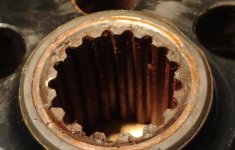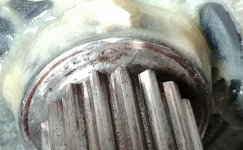-
There were many reasons for the change of the site software, the biggest was security. The age of the old software also meant no server updates for certain programs. There are many benefits to the new software, one of the biggest is the mobile functionality. Ill fix up some stuff in the coming days, we'll also try to get some of the old addons back or the data imported back into the site like the garage. To create a thread or to reply with a post is basically the same as it was in the prior software. The default style of the site is light colored, but i temporarily added a darker colored style, to change you can find a link at the bottom of the site.
You are using an out of date browser. It may not display this or other websites correctly.
You should upgrade or use an alternative browser.
You should upgrade or use an alternative browser.
Rust dust
- Thread starter billybovine
- Start date
troop
Well-known member
Does the dealers have the bolt. Cheap cycle parts has it but shipping and tax comes to more than the cost of the bolt.
Lee at Englehart's gets my stuff quick. With your closest dealer being a bit away, shipping cost might be plausible.
https://www.ebay.com/itm/Can-Am-OEM...099640?hash=item4b7fb4c178:g:xgIAAOSwfQlfX8IS
https://www.ebay.com/itm/Can-Am-OEM...099780?hash=item4b7fb4c204:g:OfEAAOSwg-NfYQRS
PMK
Active member
Screw-Hex. Flange DIN.6921 S.Grip
250001017
$10.49
I do not have my Spyder maintenance logs handy. Is that the part number for the large flange bolt or the original bolt with small flange. I ask since last week a person posted that they ordered from Cheap Cycle Parts and was sent the old style vs the later upgraded style.
pegasus1300
Well-known member
Do not use Moly Grease. Use Moly Paste. As for the bolt, the reason for not reusing it is on account of the pre applied threadlocker which is considered one time use. The bolts are not torque to yield so structurally they are fine. Be aware that on line suppliers are still selling the old style bolt / washer setup. Last week on the FB group a person showed his recently replaced bolt that he purchased on line and it was the older type.
PMK what is the difference between moly paste and moly grease? TIA.[
jcthorne
Well-known member
I do not have my Spyder maintenance logs handy. Is that the part number for the large flange bolt or the original bolt with small flange. I ask since last week a person posted that they ordered from Cheap Cycle Parts and was sent the old style vs the later upgraded style.
The two styles have different part numbers. The parts catalogs for 2014 and 15 still show the older bolt and washer. Nothing wrong with the old one as long as you use it with the washer. You can use the new style with the large flange on any of them as well.
Its likely that Cheap Cycle Parts sent the part number ordered. The PN has not been superseded and both are still available.
jcthorne
Well-known member
PMK what is the difference between moly paste and moly grease? TIA.[
Moly grease is a grease with moly added to supplement its high pressure lubrication qualities.
Moly paste is made of moly powder with just enough grease or other compounds to hold it together as a paste. The moly IS the lubricant, not an additive.
Moly paste works well in extreme pressure situations and does not wash out or melt like petroleum based grease. Spline lubes are almost always a form of moly paste.
....... When I mentioned why they should, the reply was, we've never seen a spline failure. That's hard to believe.
....... They reported no problem at 14000km, and they also told me they had never seen a spline failure. Why wouldn't I believe them ?
Admittedly, some dealers just might not ever bother to keep aware of what's happening in the broader Spyder community and so they really may not be aware of this as an issue (poor product awareness & customer service!
But only cos it's not usually the shaft or the spline on the shaft that fails, it's the bloody bore in the pulley that goes ON the spline that craps itself! :banghead:
PMK
Active member
The two styles have different part numbers. The parts catalogs for 2014 and 15 still show the older bolt and washer. Nothing wrong with the old one as long as you use it with the washer. You can use the new style with the large flange on any of them as well.
Its likely that Cheap Cycle Parts sent the part number ordered. The PN has not been superseded and both are still available.
I bought mine from the local dealer. I know the guys there, got the impression the earlier style had been superseded, but honestly did not read it or see it myself. Whatever Kevin did while looking up the PN, he got the large flange for me though. If both are still available then I doubt it makes a difference which is used.
I plan to reuse our large flange bolt since I did drill it and locwire it.
stmike 1800
Member
I do not see why some are so concerned ,as long as the bolt has loctite put on it .The bolt does nothing but stop the sprocket from sliding off .
Mikey
Well-known member
The long and the short of it, is that I believe we are all thinking this one a little to hard!!!! To me this is nothing more than a case of shorty quality control like the darn wheel nuts on the F3's!! They got a bad batch of pulleys that didn't get heat treated enough and there you go. Yes they should put some type of never seize or grease, or what ever you want to call it on there, hell I don't put anything back together with out some thing, because I don't want problems taking it apart next time I have to work on it! As far as the bolt well to me 115-120 ft lbs isnt that much for that bolt, if you feel you need to replace it, do it, would I put Loctite on it, yes on that, but I would not put anything stronger than a blue! We all tend to take things to the upper limits, when some times we throw good money over bad for what, nothing!!! This red rust seems to be a fragmented issue, it's scattered all over the place, no rhyme to reason, ether they did install the pulleys the right whey to start with, or they got a bad batch of pulleys! Anyway it's some thing else for us to keep a eye on and maintain, like oil changes, and tire pressures!! Have a good day, I am off my soap box!!! Maybe we can beat this one to four pages!!:yikes:
Maybe we can beat this one to four pages!!:yikes:
JP58
Active member
The part number for the flange bolt is 705502292. Just ordered mine from my dealer who doesn't keep at least one in stock. When I mentioned why they should, the reply was, we've never seen a spline failure. That's hard to believe.
I was told the part number is 250001017 That is what I just ordered. Is it wrong?
RICZ
New member
I guess we will both find out. I ordered by phone from my dealer and the parts gal looked it up. Fingers crossed.I was told the part number is 250001017 That is what I just ordered. Is it wrong?
PinkRosePetal
New member
70550 2292 is the part number for the bolt, unless it's been superseded.
70550 2134 is the part number for the latest front sprocket.
70550 2134 is the part number for the latest front sprocket.
Bottomline2000
New member
To the original poster... If your sprocket is only lightly worn, ie. after cleaning up is slips back onto the shaft nicely with little play then imho it's better to use it rather than fit a replacement. The reason is that the contact surface of the sprocket against the flange of the shaft is small (marginal imo and part of the original issue.). These contact surfaces will be worn because of their movement against each other but on the plus side they are worn into each other and have good contact so will fit well upon tightening.
If using a new sprocket the contact surface with the shaft flange will be smaller because the slightly worn part of the shaft will not make contact with the new sprocket. The new contact area will be smaller diameter and consequently have less surface area to carry the end load. I'm sure BRP have taken this into account because the updated sprocket is machined with a wider contact surface so as to be better usable on a worn shaft and also provide a larger contact area on a new shaft.
Important! Be sure when the sprocket is refitted that the shaft end is sufficiently recessed in the sprocket that the bolt flange cannot come into contact with it when fully tightened.
The output shaft is hardened steel. The sprocket is usually the casualty when you see the red dust.
PinkRosePetal
New member
PMK
Active member
The output shaft is hardened steel. The sprocket is usually the casualty when you see the red dust.
Exactly as it should be. Those persons insistent upon BRP has a batch of faulty pulleys that were incorrectly heat treated would be super disgusted if hardened pulleys had been installed.
Never researched heat treatment of cast steel, but suspect the pulley is not or is low heat treat capable.
Correctly lubricated is the key. Works well in bearings, transmissions, engines etc. Dry fit dynamic parts never fare well when compared to lubricated parts, unless slippage is a concern.
PMK
Active member
Too much presumption! The shaft is indeed hardened steel and the sprocket is cast iron.
See the pictures below for the wear on both. You can see the mating lines where both parts are worn together.
Want to add, if a person is removing the pulley to accomplish a wear inspection with intentions to clean and reuse the pulley, painting or somehow placing an index mark so the pulley is installed onto the same mating splines is a good thing.
Prior to removing our pulley years ago for inspection / lube / reinstall, I marked the gearbox shaft and pulley with a very slight index. Forget if I filed or used a small cut off wheel. Reassembly had it all back in the same orientation.
Yes, the do wear together.
Freddy
Active member
I do not see why some are so concerned ,as long as the bolt has loctite put on it .The bolt does nothing but stop the sprocket from sliding off .
:gaah: Ignorance is bliss.
Similar threads
- Replies
- 10
- Views
- 1K
- Replies
- 37
- Views
- 10K
- Replies
- 5
- Views
- 564
- Replies
- 1
- Views
- 504
- Replies
- 9
- Views
- 2K


